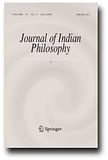Journal of Indian Philosophy 2011 - 39,3
Verfasst von pw am Mo, 07/25/2011 - 22:24.
Journal of Indian Philosophy
Journal of Indian philosophy / Editor-in-Chief: Phyllis Granoff. - Vol. 39,3. - Dordrecht [u.a.] : Springer [u.a.], 2011.
ISSN 0022-1791 (Printausg.)
ISSN 1573-0395 (Online-Ausg.)
URL: Homepage
URL: Online-Ausg. (Springerlink)
Inhalt: 39,3 (2011)
Mattia Salvini: Upādāyaprajñaptiḥ and the Meaning of Absolutives: Grammar and Syntax in the Interpretation of Madhyamaka. - In: JIP. - 39,3 (2011), S. 229-244
DOI: 10.1007/s10781-010-9121-9
DOI: 10.1007/s10781-010-9121-9
Abstract: The article discusses the relevance of the syntactical implications of the absolutive ending (lyabanta) in interpreting the Madhyamaka term upādāyaprajñapti, and hence Mūlamadhyamakakārikā 18.24. The views of both Sanskrit and Pāli classical grammarians are taken into account, and a comparison is made between some contemporary English translations of MMK 18.24 as against Candrakīrti’s commentary. The conclusion suggests that Candrakīrti is grammatically accurate and perceptive, that he may have been aware of the tradition of Candragomin’s grammar, and that the structural analogy between upādāyaprajñapti and pratītyasamutpāda may be relevant in understanding the relationship between notional and existential dependence.
Claus Oetke: Two Investigations on the Madhyamakakārikās and the Vigrahavyāvartanī. - In: JIP. - 39,3 (2011), S. 245-325
DOI: 10.1007/s10781-010-9123-7
DOI: 10.1007/s10781-010-9123-7
Abstract: Purpose of the article is to provide support for the contention that two fundamental treatises representing the teaching of Madhyamaka, viz. the Mūlamadhyamakakārikās and the Vigrahavyāvartanī, were designed to establish and justify a metaphysical tenet claiming that no particulars of any kind can exist on some level of final analysis and that this was the only primary concern of those works. Whereas the former text is in the first place dedicated to providing proofs of the central metaphysical thesis the major objective of the second treatise lies in a defense of the claim against possible objections. A correlate of this view regarding the content of those two works is on the one hand that the philosophy of the founder of the Madhyamaka-school essentially consists in a metaphysical teaching implying a radical rejection of a stance propagated in earlier Buddhist schools according to which objects of ordinary experience could be reduced to or explained by the existence of other sorts of particulars that can be theoretically postulated. On the other hand the exegesis advocated in the article implies that theorems pertaining to the nature of language or the relationship between language and non-linguistic reality are not at all a predominant issue in the pertinent texts and presumably were not a major matter of concern of early Madhyamaka in general. Accordingly matters pertaining to questions of semantics attain relevance at best in the form of objective consequences which the metaphysical doctrine might entail. The paper focuses on the second chapter of the Mūlamadhyamakakārikās as well as the segment of the Vigrahavyāvartanī which deals with the first major problem, represented by the verses 1–4 and 21–29. The reason is that a detailed and thoroughgoing investigation of these two textual passages is suited to disprove a contention voiced by Western scholars who suppose that the teaching of the founder of Madhyamaka embodies a particular claim pertaining to the relationship between language and non-linguistic reality.
Paul Dundas: Textual Authority in Ritual Procedure: The Śvetāmbara Jain Controversy Concering Īryāpathikīpratikramaṇa. - In: JIP. - 39,3 (2011), S. 327-350
DOI: 10.1007/s10781-011-9129-9
DOI: 10.1007/s10781-011-9129-9
Abstract: The ceremony of īryāpathikīpratikramaṇa in which a renunciant or lay person repents for any violence inflicted on living creatures during motion is one of the central rituals of Jain disciplinary observance. The correct procedure for this ritual and its connection to sāmāyika, temporary contemplative withdrawal, were discussed during the first millennium CE in the Śvetāmbara Āvaśyaka literature. The Āvaśyaka Cūrṇi and the Mahāniśītha Sūtra offer two alternative orderings, with the former text prescribing that īryāpathikīpratikramaṇa be carried out after sāmāyika and the latter text recommending that no religious activity should be engaged in without being preceded by īryāpathikīpratikramaṇa. The validity of these apparently contradictory ritual structures was debated by Dharmasāgara of the Tapā Gaccha and Jayasoma of the Kharatara Gaccha in the context of intra-Śvetāmbara controversy over scriptural hermeneutics in the sixteenth and seventeenth centuries.
Ähnlich
- Sambhasa 2013 - 30
- Journal of Indian Philosophy 2011 - 39,6
- Sambhasa 2011 - 29
- Studies in Indian philosophy and Buddhism 2011 - 18
- Journal of Indian Philosophy 2011 - 39,4-5
- Journal of Indian Philosophy 2011 - 39,2
- Journal of Indian Philosophy 2011 - 39,1
- Asian Philosophy 2011 - Vol. 21,1
- Journal of Indian Philosophy 2010 - 38,2-4
- Journal of Indian Philosophy 2010 - 38,1

